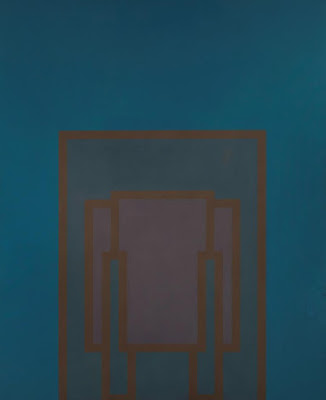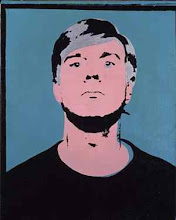 |
| Robyn Denny, Away (Here and Then Series), 1968-72 |
RobynDenny was a significant figure in the development of post-war British abstract painting. In David Mellor’s judgement, “For eight years between 1961 and 1969, Robyn Denny painted what are arguably some of the most accomplished abstract paintings made in Britain in the twentieth century.” He is best known for his geometric abstractions of the 1960s and 70s. In 1973 he was the youngest artist to be given a retrospective at the Tate. His dedication to abstraction, however, meant that he became increasingly unfashionable and, together with contemporaries such as Richard Smith, all but disappeared from public view. (In an interview, entitled ‘The Invisible Man’, Richard Smith recalled: "Robyn Denny keeps saying, 'Our time will come, Dick. Our time will come.' And he's been saying this for years and years.")
As a student in the 1950s (St Martin’s, 1951-4, RCA, 1954-7), Denny belonged to the first generation to be influenced by the American Abstract Expressionists, principally through exhibitions at the Tate (1956 and 59), and shows by Pollock (1958) and Rothko (1961) at the Whitechapel.
Denny’s early work was characterised by gestural painting and typographical abstraction. The apotheosis of the latter was a mural commissioned for Austin Reed (‘great, big, wide, biggest’) in 1959.
In 1960 Denny was a key player in the organisation of ‘Situation’, an exhibition which responded directly to the scale and innovation of the American painters. The criteria for inclusion in ‘Situation’ were that paintings should be ‘abstract (that is, without explicit reference to events outside the painting) … and not less than 30 square feet.’ All accounts report that the exhibition was poorly attended, but the label recurred in ‘New London Situation’ at the Marlborough Gallery in 1961 and in an Arts Council exhibition, ‘Situation: an exhibition of recent British abstract art’ in 1962.
The paintings of the 60s were typically, large-scale, featuring geometrical forms, suggestive of doorways, with flat planes of colour in precisely adjusted, usually, muted colours. Later work changed the emphasis from vertical to horizontal and included areas of brilliant colour. In 1981 Denny moved to Los Angeles and made paintings which were typically monochromes out of which outcrops of scratched, coloured marks would emerge.
It is wonderful that this overlooked artist is now being shown in this exhibition.
Waldemar Janusczak has tweeted re this exhibition - "Go see everyone. I love Robyn Denny's work." Well, me too - but I fear I am unlikely to get to Newlyn in the next few months; I hope the exhibition will tour.
 |
| Robyn Denny, Line Up 2, 1962 |
 |
| Robyn Denny, By Day 4, 1967 |
 |
| Robyn Denny, Aday 2 (Here and Then Series), 1968-73 |
 |
| Robyn Denny, Sweet Nature 4, 1976-77 |



No comments:
Post a Comment